Overview septic tank for giving “Topas”: principle of operation, device, advantages and disadvantages
Septic tanks are one of the most effective options for organizing autonomous wastewater treatment. These devices are not too cheap, but they are convenient and reliable.
To understand why it is worth or not worth installing such a device on the site, you should study the principles of its operation. This is what we will be talking about in this article. As an actual example, we will use a septic tank to give Tapas.
And also consider in detail the device of such a system, highlight the main pros and cons, give recommendations on the operation and maintenance of the septic tank.
The content of the article:
How does a typical septic tank work?
Septic tank is a type of sewer device specially designed for the complete or almost complete processing, clarification and disinfection of sewage wastewater.
The operation of the device is based on the principle of biological treatment. Active oxygen and special bacteria are used as the active component, which decompose effluents into water and neutral sludge.
At the same time, sludge serves as a binding component, inorganic waste that does not lend itself to bacterial processing also settles in it.
The water obtained as a result of cleaning is usually removed from the device through the earthen filter of the absorption well, the filtration field or otherwise. With the proper level of treatment, water can be used to water plants on the site.
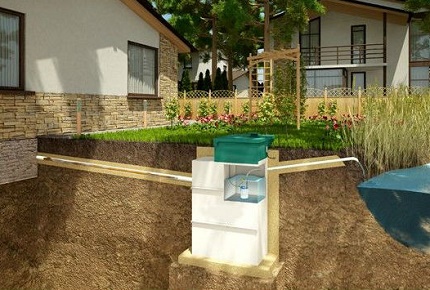
For processing organics use bacteria for septic tankswhich are anaerobic and aerobic. The former live and process wastewater in an oxygen-free environment, which provides completely sealed containers. The second ones work only in conditions of unhindered supply of oxygen.
Regardless of the species, these microorganisms are able to reproduce themselves, so the septic tank does not need regular addition of bacteria to the drains, although in some cases this has to be done.
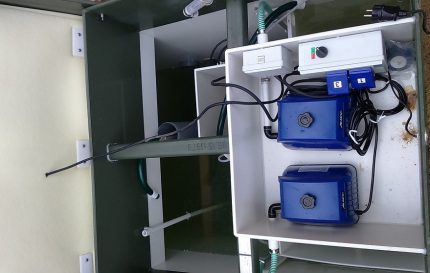
Like any device, a septic tank requires proper care. In particular, accumulated sludge must be removed annually. From a conventional cesspool, septic tanks are favorably distinguished by the fact that the processing process completely neutralizes all unpleasant odors.
If the device is installed correctly and is used in accordance with the manufacturer's recommendations, usually there are no problems with it.
Varieties of designs and model range
To understand the principles of operation of a septic tank of the “Topas” type, you should study its design. Externally, this device is a large cube-shaped container with a large square lid.
Inside, it is divided into four functional sections. There is a built-in device for air intake from the surface to ensure that the effluents are saturated with oxygen.
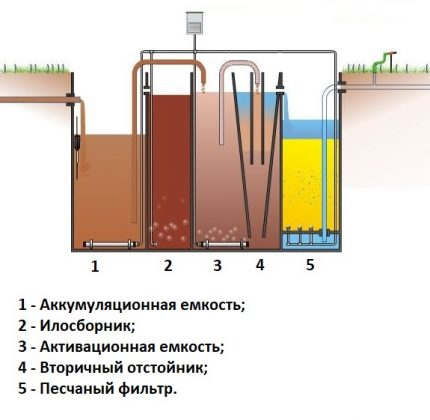
Inside the treatment system are the following elements:
- a receiving chamber into which the drains enter initially;
- airlift with pumping equipment, providing movement of wastewater between different departments of the device;
- aeration tank - a department in which the secondary stage of cleaning is performed;
- pyramidal chamber, where the final treatment of effluents;
- a post-treatment chamber; septic water purified during operation accumulates here;
- compressor for air injection;
- sludge removal hose;
- device for draining purified water.
The range of septic tanks of this brand is quite wide. There are models for plots and houses of different sizes, devices designed to service gas stations and even powerful treatment plants that can satisfy the needs of a small village.
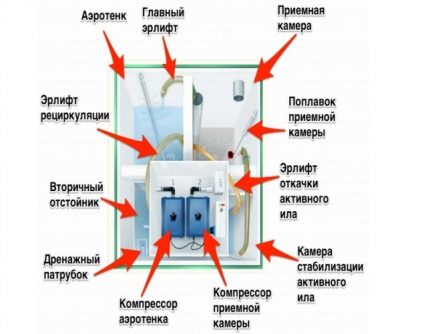
In private housebuilding, septic tanks “Topop-5” and “Topop-8” are most often used. The number next to the name indicates the approximate number of residents for whose servicing the device is designed.
“Topop-5” has more compact dimensions and lower productivity, it is able to easily meet the needs of a family of five in sewerage services.
This model is considered an ideal choice for a relatively small cottage. Such a device can process about 1000 liters of effluents per day, and the simultaneous discharge of waste within 220 liters will not cause any septic tank.
The dimensions of Topop-5 are 2500X1100X1200 mm, and the weight is 230 kg. The power consumption of the device is 1.5 kW per day.
But for a large cottage it is better to take “Topas-8”. The size and ability to process wastewater in this model is much higher. Such a septic tank is capable of serving even the areas on which the pool is arranged, although in such a situation the Topas-10 may be more appropriate.
The performance of such models varies between 1500-2000 liters of effluent per day.
The numbers next to the name of the septic tank indicate the number of people that this device can serve while using. Customers are guided by these indicators, choosing the suitable model.
There is also a letter marking that describes the specific operating conditions for which a particular device is designed.
For example, the designation “Long” indicates the possibility of using this septic tank with a connection depth that exceeds 80 cm. Marking “Pr” indicates models with the option of forced pumping out partially purified water.
Such designs are additionally equipped with a pump. Models marked “Pr” are used in areas with high groundwater levels.
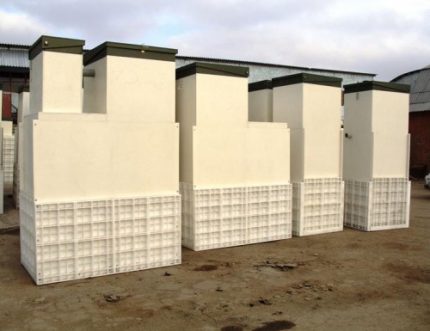
The presence of a pump in the device of this model of a septic tank Topop is intended for installation on a site with clay soils that poorly filter or do not absorb purified water at all. The marking “Us” stands for “reinforced”.
These are more powerful models that should be used if the depth of installation of the septic tank exceeds the level of the location of the sewer pipe by 1.4 m or more.
The higher the pump performance, its power and the more options it has, the more expensive it will be to purchase it, and the more difficult it will be to install it. Therefore, you should not choose a wastewater treatment plant, if in the near future the number of residents in the house should not increase sharply.
More detailed recommendations on choosing a septic tank for a summer residence are considered in our other article.
The principle of operation of septic tanks “Topas”
Through the sewer pipe, the effluent enters the first receiving chamber. Here, the sewer masses are fermented with the active participation of anaerobic bacteria.
When the level of wastewater in the receiver reaches a predetermined level, the waste begins to be pumped to the second chamber using an airlift.
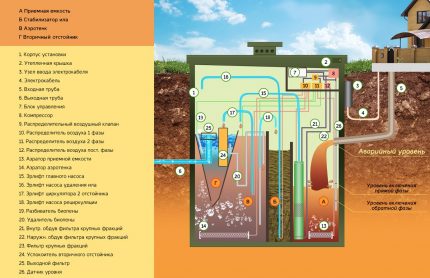
In the second section of the septic tank, aeration of wastewater is performed, i.e. their saturation with air, which is necessary in order to activate the work of aerobic microorganisms digesting sewer organic matter.
Bacteria actively process the contents of the sewer, turning it into a mixture of partially clarified and purified water and activated sludge.
After processing in the second chamber, everything moves to the department of the sludge stabilizer - biomass, which is actively involved in cleaning the liquid component of the sewer mass. Here the sludge settles, and the water released as a result moves into the sump.
To improve the quality of treatment, part of the water and mobile sludge from the stabilizer enters the primary chamber so that secondary wastewater treatment can be performed.
Thus, the topop septic tank operating scheme provides for the circulation of effluents through the various compartments of the septic tank until the level of treatment reaches the required quality level. This ensures high environmental safety for recycled wastewater.
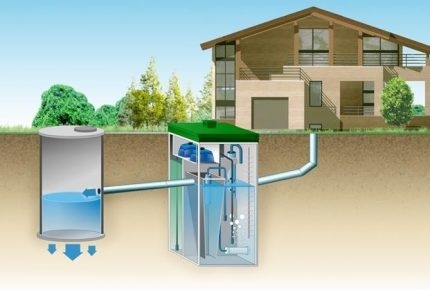
At the end of multistage processing, purified water is discharged to filter fields or absorbing (filtering) well, where the wastewater is treated and dumped into the ground.
If it is not possible to arrange a filtering well or drainage system, clarified and disinfected liquid can be discharged into the gutter.
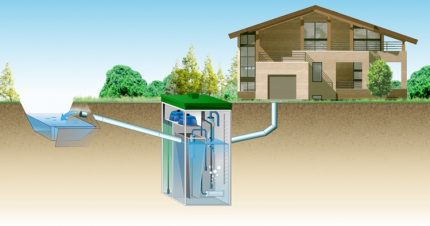
In the absorption well or in the filtration fields, post-treatment is carried out by passing sewage through filtering soils. In the first case, the post-treatment design is a pit with a permeable bottom, on which a meter-long layer of rubble or gravel with sand aggregate is laid.
The filtration field is a kind of drainage system made up of perforated pipes - drains. Flowing along drains, the liquid component of the effluent is additionally cleaned and seeps through the perforation of the pipes into the surrounding soil.
We also recommend that you familiarize yourself with the styling features. drain pipe.
When laying all types of sewer pipelines, including the drainage system, it is necessary to take into account the level of soil freezing in the winter so that the sewage does not freeze and create plugs in the channel intended for their flow.
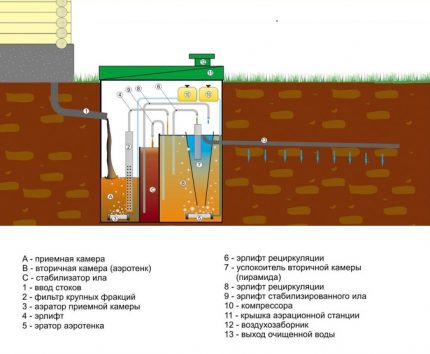
Advantages and disadvantages of the system
Septic tanks “Topop” have been used in Russia and neighboring countries for more than two decades. During this time, buyers fully appreciated the merits of the septic tank tobas and identified its shortcomings.
Judging by the fact that the demand for septic tanks is not decreasing, the autonomous sewage of this brand can be considered quite reliable.
Thanks to the biochemical scheme of work and multi-stage purification of the septic tanks, Topops process up to 98-99% of organic pollutants, i.e. provide almost complete neutralization.
Installation of the device is relatively simple, it does not require complex preparatory work, such as pouring concrete, etc. It is not necessary to regularly call the truck of sewage trucks, as owners of cesspools are forced to do.

Of course, airlift, compressors and other components require constant access to power. However, the cost of electricity for such a septic tank is relatively small, as well as the total operating costs for its maintenance.
The water obtained as a result of the septic tank can be used for irrigation, and the sludge that accumulates in the tank can be used as fertilizer for the soil on the site, which somewhat reduces the cost of not improving it.
Septic is a closed system, so no unpleasant odors of the residents of the house will bother. There is completely no unpleasant noise, since the device is in the ground, and its components and mechanisms are very quiet.
Such a septic tank can be used on almost any type of soil. Like almost any autonomous sewer system, the “Topas” septic tank is underground, i.e. does not damage the landscape of the site.
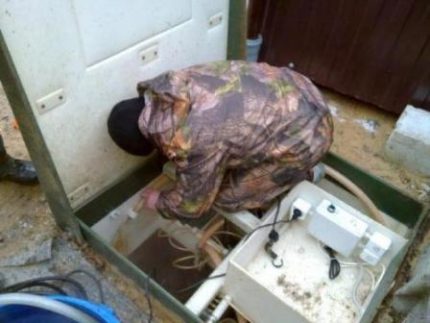
Such a device does not need serious insulation measures, except in an area with a very harsh climate. Microorganisms in the course of waste processing generate a certain amount of thermal energy, which does not allow the tank to freeze.
The manufacturer assures that, with proper installation and operation, the “Topas” septic tank can last about 50 years.
Among the disadvantages of the device, its dependence on electricity is most often mentioned. If power outages occur frequently and for a long time, then it makes sense to take care of an additional power source.
Another “minus” - a relatively high price, if desired, you can find a septic tank and cheaper. But the positive characteristics and reliability of the device fully justify the cost.
In reviews, sometimes complaints are made about the incorrect operation of Septic tanks “Topas” or even for breakdowns. In practice, it is usually found that the owners themselves are to blame for the problems: either the device was installed and started incorrectly, or the rules for its operation were not followed.
Installation and Installation Rules
To set the septic tank “Topas”, especially its compact models, it is not necessary to invite a specialist. This can be done even without the help of special equipment, although its absence will make the work harder and longer. First you need to dig a pit of suitable size and configuration.
For “Topop-5”, a pit with dimensions of about 1.8X1.8X2.4 m is suitable. For a larger device, you will need a large pit. A space of approximately 200 mm should remain between the walls of the septic tank and the soil.
A sand cushion is being constructed at the bottom of the pit, a rammed layer of 100-150 mm will be enough. Then down and set the capacity of the septic tank. The device should be perfectly aligned to check its position, using the usual building level.
After that, a sewer pipe is brought to the device and, at the level of its connection, a hole is cut along its perimeter, because the inlet pipe is not structurally provided due to the difference in the depth of connection in different areas.
The pipe is welded using the supplied welding rod.
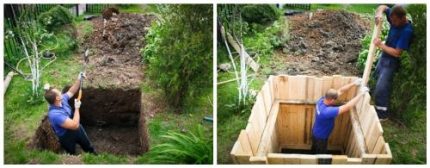
Then, the power supply is connected to the cleaning object. The cable is protected with a corrugated pipe and laid in the same trench as the sewer pipe. After that, a pipe segment connecting the septic tank to the after-treatment system selected by the owners is connected to the outlet pipe.
The technical stuffing is installed in a tank immersed in the foundation pit and, if necessary, lined: a pump, if provided, a compressor.
To remove methane, which is formed during the biological treatment of effluents, it is necessary to install at least one ventilation riser. A suitable place for its location is the exit of the sewer pipeline from the house.
Ventilation can be arranged at the outlet of the septic tank, but it is better to use both options in the complex.
After installing all the functional parts and verifying the correct connection, they begin to backfill the pit. In order to balance the external pressure of the soil on the walls of the septic tank, it is simultaneously filled with water with backfill. Injected water will gradually be displaced as the flow and treatment of effluents.
Recommendations for use
In order for the septic tank to work properly and for a long time, it should be used in accordance with the rules established by the manufacturer. It is necessary to avoid moving inorganic waste of various inorganic waste, for example, plastic, polyethylene, construction waste, etc.
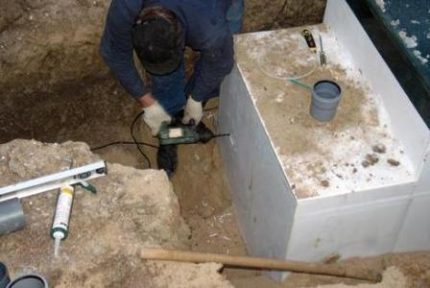
Such substances are not susceptible to bacterial processing, so at best they simply settle in the septic tank, reducing its useful volume and productivity. In the worst case, the presence of inorganic contaminants can lead to damage to the septic tank or equipment damage.
A detailed overview of common breakdowns of the septic tank “Topop” and methods for their elimination are considered in this article.
It is not recommended to pour into the sewer substances that contain antibiotics, as well as chlorine or manganese compounds, since this creates an environment hostile to bacterial cultures, they can simply die.
If the number of bacteria in the septic tank decreases markedly, waste processing will slow down and an unpleasant odor will appear in the septic tank.
For the same reasons, it is not allowed to use a septic tank to dispose of a large amount of alcohol-containing liquids, industrial oils, antifreeze, acid or alkali of high concentration, for example, household cleaners.
Do not let the wool down the drain. Although it is an organic substance, it cannot be processed quickly in a septic tank, but it can cause clogging of the device.
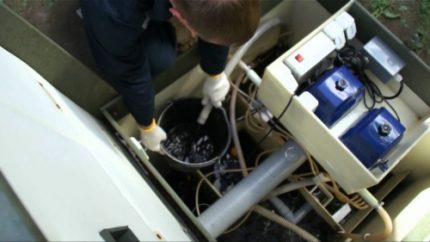
Problems can arise as a result of a power outage.If the septic tank does not work, and the waste continues to flow, this will lead to overfilling of the tank, resulting in uncleaned mass entering the ground.
In case of short power outages, it is recommended to reduce the amount of effluents entering the sewer if possible. In case of long outages, an alternative source of electrical energy should be provided.
Regular technical septic tank service help you to notice problems in time and prevent possible problems. The purity of the resulting water treatment should be checked from time to time.
If the amount of pollution increases, you should find the cause and eliminate it: adjust the septic tank, update the composition of bacterial cultures, etc.
Approximately three or four times a year, the accumulated sludge should be pumped out of the tank using a special hose, as well as the tank where non-processed waste is accumulated. Every two years, the compressor membranes must be replaced with new ones so that these mechanisms work correctly.
But the filters need to be replaced every month, they quickly become dirty. The aerator is rarely replaced - every 12 years, but do not neglect this measure.
If the septic tank is not to be used in the winter, it is necessary preserve properly.
It should be understood that this is not a heating system, the complete pumping of liquid from the septic tank will have a detrimental effect on the bacteria settled in the device. Before preservation, the device is cleaned and left partially filled with water.
Conclusions and useful video on the topic
The process of work and installation of the septic tank “Topas” is described in the following material:
The installation procedure for the “Topas” septic tank is shown in detail here:
This video shows the procedure for cleaning and maintaining septic tanks of this type:
Septic tanks “Topas” are reliable and useful devices. They are quite diverse in terms of functional features and price, which allows you to choose the right septic tank option for any site.
It is very important not only to choose the right septic tank for your home or summer house, but also to carry out its competent installation and regular maintenance. In this case, the device will work for a long time.
Do you have a compact septic tank from the Topas family installed in the country? Tell me, did you install it yourself or did you call the wizard? How often do you clean it and are you satisfied with the overall system? Leave your comments and add a photo of your septic tank in the block under this article - your review will be useful to many owners of cottages.

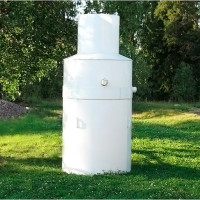 Overview of the cedar septic tank: device, principle of operation, advantages and disadvantages
Overview of the cedar septic tank: device, principle of operation, advantages and disadvantages 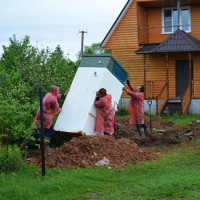 Overview of the Eco-Grand septic tank: device, principle of operation, advantages and disadvantages of the system
Overview of the Eco-Grand septic tank: device, principle of operation, advantages and disadvantages of the system 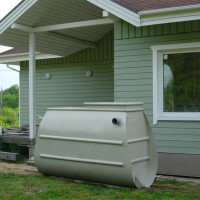 Overview of the Tver septic tank: device, principle of operation, advantages and disadvantages
Overview of the Tver septic tank: device, principle of operation, advantages and disadvantages 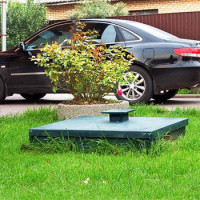 Overview of the septic tank for the cottage “Unilos Astra”: device, service rules, advantages and disadvantages
Overview of the septic tank for the cottage “Unilos Astra”: device, service rules, advantages and disadvantages  Septic “Uponor”: device, advantages and disadvantages, review of the model range
Septic “Uponor”: device, advantages and disadvantages, review of the model range 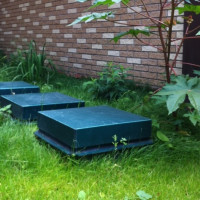 Overview of the septic tank “Leader”: device, principle of operation, advantages and disadvantages
Overview of the septic tank “Leader”: device, principle of operation, advantages and disadvantages  How much does it cost to connect gas to a private house: the price of organizing gas supply
How much does it cost to connect gas to a private house: the price of organizing gas supply  The best washing machines with dryer: model rating and customer tips
The best washing machines with dryer: model rating and customer tips  What is the color temperature of light and the nuances of choosing the temperature of the lamps to suit your needs
What is the color temperature of light and the nuances of choosing the temperature of the lamps to suit your needs  Replacement of a geyser in an apartment: replacement paperwork + basic norms and requirements
Replacement of a geyser in an apartment: replacement paperwork + basic norms and requirements
The septic decided to install right next to the garden in the summer cottage, this allows me to use the resulting water to water my apple tree with plums. Hastened with bacteria, added aerobic, have to keep open. Is there any way to rectify the situation? As I understand it, I’ll have to clean out the entire septic tank system, while I'm afraid to climb it myself. 3 months have passed since use.
From what I read, the septic tank Topas suits me the most. But we have a big problem with power outages in the village. I already managed to get upset, but one of the Topas dealers assured me that they could stand without electricity and use for up to two weeks and there would be nothing wrong.Now I don’t even know what to do now - trust sellers who are interested in saying anything, but selling or taking a septic tank is simpler, which is not so dependent on electricity.
Good afternoon, Olga.
If we talk about power outages for a couple of hours a day, then you can not worry. For the septic tank Topop, voltage surges are more dangerous than the lack of electricity, as such. You definitely need to install a voltage stabilizer.
In the absence of light, try to minimize the use of sewers. I admit that an alarm has been set, which is triggered during the overflow of the reception chamber.
Without electricity, throwing off drains, you cannot control the septic tank filling level. The chance of flooding the unit with the electronics becomes quite high. The ingress of liquids will lead to the complete failure of the septic tank and, as a result, to expensive repairs.
It is recommended for septic tanks Topas to arrange an alternative supply of electricity. With a reasonable approach, you can do with one stabilizer.